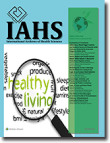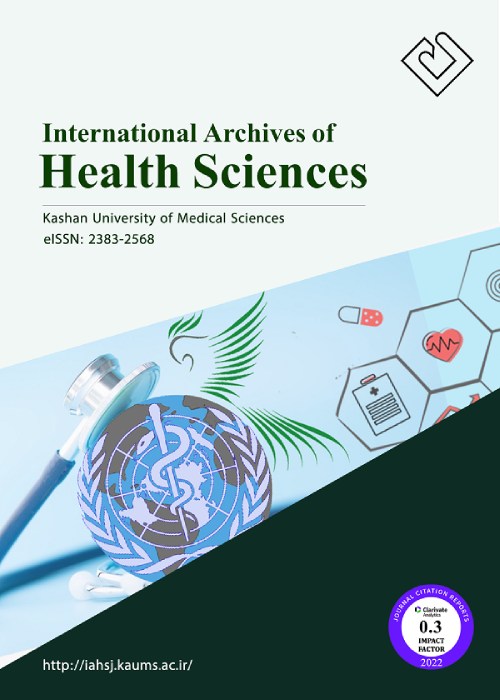فهرست مطالب

International Archives of Health Sciences
Volume:9 Issue: 2, Apr-Jun 2022
- تاریخ انتشار: 1401/03/11
- تعداد عناوین: 5
-
-
Pages 77-82Aims
Diabetes is a chronic, progressive, and metabolic disease that its prevalence is increasing in the world. Poor treatment adherence is a barrier to controlling diabetes. The aim of this study was to evaluate the treatment adherence and blood sugar control in patients with diabetes and related factors.
Materials and MethodsThis descriptive‑analytical study was performed on 385 patients with diabetes in 2020–2021 at both Aran and Bidgol health centers. A proportion of diabetic patients in each center were selected based on the covered population by simple random sampling. The tools was Madanloo’s treatment adherence questionnaire and also measured glycosylated hemoglobin (HbA1C) level of patients during the last 3 months. Data were statistically analyzed by SPSS‑19. T‑test, analysis of variance, Spearman correlation coefficient, Tukey, and multiple linear regression were used.
ResultsThe mean ± standard deviation total score of treatment adherence was 61.43 ± 10.02 that 15.1% of patients had a mean adherence score, 79.5% had a good adherence score and 5.5% received a very good treatment adherence score. Various factors such as marital status (P = 0.013), employment status (P = 0.003), housing status (P = 0.001), other diseases (P = 0.004), drug side effects (P = 0.001), belief in the need for medication (P = 0.001), insurance (P = 0.002), number of children (P = 0.003), and monthly income (P = 0.003) affect the rate of adherence to treatment.
ConclusionThe treatment adherence in patients with diabetes was desirable. The results of the research can be used to design interventions to increase compliance with treatment to better control HbA1C and diabetes and reduce treatment costs.
Keywords: Blood sugar, diabetes, treatment adherence -
Pages 83-88Aim
The aim of this study was to determine the tuberculosis (TB)‑related social stigma and health beliefs among residents of Gorgan’s rural areas, North of Iran.
Materials and MethodsIn this cross‑sectional research, 672 individuals in Golestan were enrolled. The target group included non‑TB individuals aged 15 years and above with no TB patients in their families at the time of study. They were selected by two‑stage cluster sampling. The data collection tool was a researcher‑made questionnaire consisting of 2 sections. The first section included demographic information. The second section was related to the questions of perceived susceptibility (n = 5), perceived severity (n = 7), and social stigma (n = 11) measures. Data analysis was carried out using SPSS version 16.
FindingsThe mean age of respondents was 33.00 ± 1.17 years. In this study, only 5.6% of the individuals had high perceived susceptibility. 97.7% of the samples had a moderate and high level of severity. This percent is 91.5% for social stigma. Pearson correlation test showed a direct relationship between perceived severity and social stigma (r = 0.30) and an inverse relationship between perceived susceptibility and perceived severity (r = −0.13).
ConclusionBased on the findings of the present study, levels of perceived susceptibility, perceived severity, and social stigma among people were moderate. Therefore, intervention studies should focus on initiating health education and health promotion programs in order to increase perceived susceptibility and decrease social stigma.
Keywords: Health belief, rural people, social stigma, tuberculosis -
Pages 89-93Aim
Unsafe behaviors (UBs) are the most important cause of accidents, so there is a need to identify the factors effective on it. The purpose of this study was to identify the factors affecting the occurrence of UBs and also to build a strong theoretical model with fuzzy logic.
Materials and MethodsThis study was conducted among 270 participants in the steel industry in Iran. The factors, such as work‑family conflict, job stress, and general health were investigated using relevant questionnaires, and the prevalence of UBs was investigated with the safety behavior sampling technique. Finally, the results were analyzed with SPSS 21.0 and MATLAB software.
FindingsThe results showed that out of 1310 samples of observed behavior, 531 UBs were observed (39.81%). There were 202 cases of nonuse or inappropriate use of personal protective equipment. General health, job stress in the supervisor, and colleagues’ support were significantly associated with UBs (P < 0.05). In addition, general health, work‑family conflict, job stress and were significantly correlated with each other (P < 0.001). Diffuse results using fuzzy logic predicted 56% of the behavioral conditions.
ConclusionsThis study showed that managing UBs is possible by controlling factors such as the support of supervisors and the way of management, as well as the reduction of social stresses such as work‑family conflict, in addition to being able to increase people’s health, also reducing accidents and UBs. Finally, using fuzzy logic, it is able to predict reality, and by knowing several behaviors, better models can be obtained.
Keywords: Fuzzy logic, job stress, occupational accidents, unsafe behaviors -
Pages 94-99Aims
The goal of this study is the rapid assessment of knowledge, attitude, and practice (KAP) of Kashan’s residents toward COVID‑19.
Materials and MethodsThe study was a cross‑sectional study and conducted among Kashan’s residents (a city in Isfahan, Iran) in 2020. The sample size was estimated to be 380. A four‑part questionnaire including demographic data (7 questions), participants’ knowledge (3 multiple‑choice questions), attitudes (6 multiple‑choice questions and five‑point Likert scale), and practices (2 multiple‑choice questions) was used to collect the data. The data were analyzed with descriptive statistics, Kendall and Cramer’s V by SPSS software.
ResultsSix hundred and fifteen participated in the study. Findings showed that more than 80% knew about symptoms and more than 85% had proper information about ways of preventing. Regarding the attitude toward prevention, 96.2% of the residents considered themselves responsible for caring. Government and municipal officials (64.5%) and health authorities (53.9%) were in the next ranks. About practice, 90% of the respondents mentioned using disinfectants, staying at home, observing hand hygiene, and avoiding being in crowded places as preventive measures. Majority of people agreed with prohibition of all public gatherings in the city.
ConclusionThis study can be a step toward planning and effective interventions by policymakers in infectious diseases such as COVID‑19.
Keywords: Attitude, COVID‑19, Kashan, knowledge, practice, survey -
Pages 100-105Aims
The purpose of this study was to determine the effectiveness of Thai massages on the general health of hemodialysis (HD) patients.
Materials and MethodsIn this clinical trial, 80 patients undergoing HD were randomly assigned to intervention and control groups. Before study, the two groups completed sociodemographic and general health questionnaire (GHQ‑28) questionnaires. The control group received routine care for HD patients. In the intervention group, 60‑min Thai massages were performed three times a week for 4 weeks. Immediately and 1 month after the last session of the intervention, the GHQ‑28 questionnaire was completed by the two groups.
FindingsThere was no significant difference between the mean scores of general health in the two groups before the intervention (P > 0.05). But, immediately after and 1 month after the last session of the intervention, there were significant differences between the two groups in the total scores of general health and the scores of physical symptoms and anxiety subscales (P < 0.05). In the intervention group, the repeated measures ANOVA test showed significant differences between the total scores of general health as well as physical symptoms and anxiety subscales over time (P < 0.001).
ConclusionA Thai massage can be considered as an effective alternative for improving HD patients’ general health as well as reducing physical symptoms and anxiety.
Keywords: General health, hemodialysis, Thai massages


